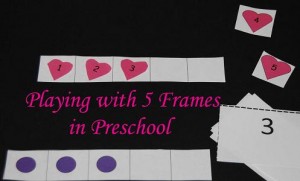 Intuitive Math: Encouraging Early Math Skills in Preschool – Numbers {Part Two}
Intuitive Math: Encouraging Early Math Skills in Preschool – Numbers {Part Two}
This post is the second in a series on encouraging intuitive math skills in preschool children. If you would like to see the first post, you can view it here!
There are 6 important number concepts that preschoolers need to have opportunities to explore through play in order to develop good math intuition skills. This numbers post (Part Two} will concentrate on the two concepts (in bold below).
6 Important Number Concepts for Preschool
Number Awareness and Recognition
One-to-One Correspondence
Subitizing
Anchors of 5 and 10
Part+Part=Whole
More Than, Less Than, or Equal To
Anchors of 5 and 10 – Subtizing and Beyond
Many parents (and some teachers) want to move quickly beyond the numbers 1-10. Preschoolers need many opportunities and invitations to play and practice with the numbers 1-10 to successfully grasp present and future math concepts. When preschoolers understand that the numbers 5 and 10 are anchor numbers, math becomes meaningful.
Fingerplays and finger counting games offer fun ways to play with the numbers 1-10. The idea is to invite your children to move beyond basic finger counting toward recognizing (intuitively, through subitizing) that one hand has 5 fingers and two hands have 10 fingers (without counting each individual finger). **Note – to view information about Subitizing, see Numbers {Part One}.
Mental Math Games: Invite your children to close their eyes and IMAGINE 5 fingers. Ask the children to count all 5 fingers silently as they envision 5 fingers with their eyes closed. Can they “see” all 5 fingers in their mind? With our children, we play a circle game where each child chooses one MENTAL MOVEMENT for the fingers we are imagining (for ex: MY 5 FINGERS are “Dancing in the night! Dance one finger, dance two, and so forth”) Each child then envisions 5 fingers dancing and/or other movements the children think of. Repeat the same mental math game, but with 10 fingers. Our kids love playing what they call: “math brain games.” Ask the children to retell their mental images; you’ll be amazed by the stories that are shared! The children will often begin playing independently and asking their peers to play with them. It is fun to observe how each of the children plays with mental math concepts; teachers and parents can learn a great deal about how our children “think math” simply by observing and listening to play.
Anchors of 5
Once children develop good Subitizing skills with the numbers 1-5, we can invite the children to play with math concepts and develop increased fluidity with the numbers 1-5.
The 5 Frame
 Some children are not exposed to only a 5 Frame. Many parents, caregivers, and educators are familiar with 10 Frame activities, but preschoolers should concentrate solely on a 5 Frame before introducing 10 Frame Activities.
Some children are not exposed to only a 5 Frame. Many parents, caregivers, and educators are familiar with 10 Frame activities, but preschoolers should concentrate solely on a 5 Frame before introducing 10 Frame Activities.
Once good Subitizing skills are developed, children will be able to look at the 5 Frame and have immediate recall of how many dots (or other objects) are located within the basic frame.
 This problem: 5-2=3 is easy for children with good recognition of numbers with the anchor of 5.
This problem: 5-2=3 is easy for children with good recognition of numbers with the anchor of 5.
5 Frame Practice – 5 Frames and Number Cards
Materials needed: Blank 5 Frames and number cards (linked above) and small items or manipulatives (small shells, dot stickers, paper clips, unifix cubes, small blocks, etc.)
Cut the individual 5 Frames apart and set out on a tray or table along with any manipulatives desired. Invite the children to cut out the number cards 1-5 and place them face down. Have the children draw a card and place the corresponding number of manipulatives within the 5 Frame. The last page of the file includes 5 Frame Dots to match to the corresponding number card with the visual in place.
Story problems: To develop mental math, use everyday story problems with the children based on the anchor of 5. Dylan had 5 crayons on the table. Macie took 4 of them. How many crayons did Dylan have left? Invite the children to think of their own stories (story problems) based on the anchor of 5 only. The story problems the children create can be used with the printable 5 Frames above. Invite the children to write the appropriate equation for their number stories (or copy/stamp the equation with number stamps).
Again, playing with numbers does not require tangible manipulatives, but for some children, the tactile manipulative will enhance learning.
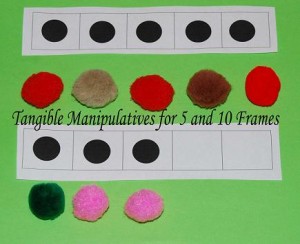
When children are able to manipulate the numbers 1-5 with consistency, combine two 5 Frames to help the children visualize the number 10 anchor.
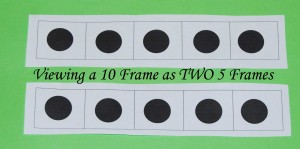
The problem below (ex: 10-4=6) is then very familiar to children who have good Subitizing Skills and 5 Frame awareness!
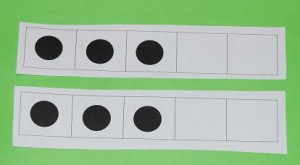
What about the same problem (ex: 10-4=6) viewed in this manner?
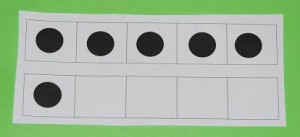
When young children thoroughly understand 5 Frames, no matter how the problem LOOKS, they will be able to intuitively “see” the answer within the 10 Frame.
10 Frame Practice and Number Cards – 10 Frames and Number Cards
The printable 10 Frames and Number Cards can be used for practice in the same manner as the 5 Frames above.
Next week, we’ll learn more about playing with the numbers 1-10 to help young children develop PART + PART = WHOLE awareness. To make sure you don’t miss any post within the Math Series, take a moment to subscribe to our blog on the right!